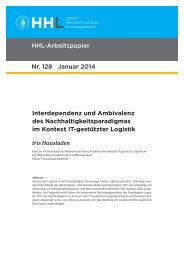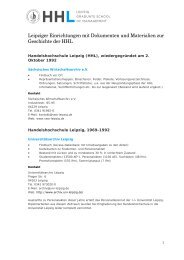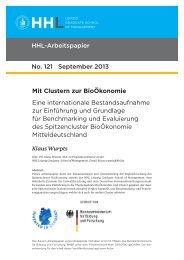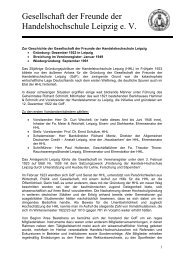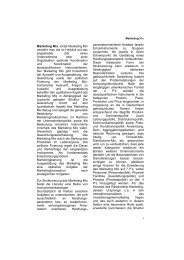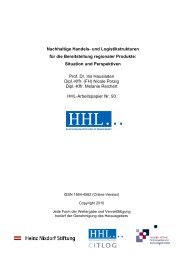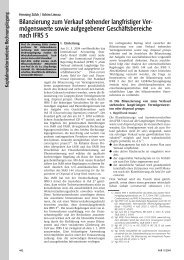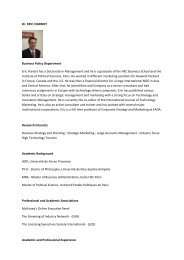Bio- and regenera- tive Medicine as an important growth Market
Bio- and regenera- tive Medicine as an important growth Market
Bio- and regenera- tive Medicine as an important growth Market
Create successful ePaper yourself
Turn your PDF publications into a flip-book with our unique Google optimized e-Paper software.
40 HHL RESEARCH REPORT 2012 innOvATiOn And EnTREPREnEuRSHiP 41<br />
Bohr’s Quadr<strong>an</strong>t<br />
(pure b<strong>as</strong>ic research)<br />
nO<br />
COnSidERATiOn Of uSE?<br />
Hobbyist’s Quadr<strong>an</strong>t<br />
(exploring particular<br />
phenomena)<br />
YES<br />
p<strong>as</strong>teur’s Quadr<strong>an</strong>t<br />
(use-inspired<br />
b<strong>as</strong>ic research)<br />
challenge of the entrepreneurial university<br />
QuEST fOR<br />
fundAMEnTAL<br />
undERSTAnding<br />
nO<br />
YES<br />
edison’s Quadr<strong>an</strong>t<br />
(pure applied research)<br />
As Stokes pointed out in his four quadr<strong>an</strong>ts, if universities aim for<br />
more use-inspired b<strong>as</strong>ic research like in P<strong>as</strong>teur’s quadr<strong>an</strong>t, they<br />
could become much stronger in making use of their knowledge.<br />
They could do this without losing their dem<strong><strong>an</strong>d</strong>ing st<strong><strong>an</strong>d</strong>ards, which<br />
would happen if they concentrated on pure applied research like<br />
in Edison’s quadr<strong>an</strong>t. The bal<strong>an</strong>ce between science <strong><strong>an</strong>d</strong> technology<br />
needs is the essential <strong>as</strong>set modern universities should possess.<br />
StiFtungSFondS deutScHe B<strong>an</strong>K cHair oF<br />
innovation M<strong>an</strong>ageMent <strong><strong>an</strong>d</strong> entrepreneurSHip<br />
the ch<strong>an</strong>ging role of<br />
uni versities <strong>as</strong> innovation<br />
engines <strong><strong>an</strong>d</strong> entrepreneurial<br />
Hubs<br />
The import<strong>an</strong>ce of the quality of<br />
knowledge for the welfare of nations<br />
c<strong>an</strong> be illustrated by a simple example .<br />
Although the physical weight of the US’s<br />
<strong>an</strong>nual exports h<strong>as</strong> not ch<strong>an</strong>ged signific<strong>an</strong>tly<br />
over the l<strong>as</strong>t one hundred years,<br />
the real value of its exports h<strong>as</strong> incre<strong>as</strong>ed<br />
twentyfold . It is the knowledge that<br />
goes into the goods <strong><strong>an</strong>d</strong> services <strong><strong>an</strong>d</strong> the<br />
processes required to produce them that<br />
determines the value of the exports <strong><strong>an</strong>d</strong><br />
their competi<strong>tive</strong>ness in world markets .<br />
Historically, the traditional school of<br />
thought h<strong>as</strong> regarded universities <strong>as</strong> a<br />
typical ‘production machine’ of hum<strong>an</strong><br />
resources . On the other h<strong><strong>an</strong>d</strong>, comp<strong>an</strong>ies<br />
encourage researchers to join their R&D<br />
department, <strong><strong>an</strong>d</strong> in some years, each of<br />
these comp<strong>an</strong>ies h<strong>as</strong> a huge R&D department,<br />
in which m<strong>an</strong>y researchers are<br />
working on rela<strong>tive</strong>ly similar t<strong>as</strong>ks with<br />
low degree of efficiency <strong><strong>an</strong>d</strong> specialization,<br />
<strong><strong>an</strong>d</strong> where ide<strong>as</strong> are developed in<br />
their central facilities, <strong><strong>an</strong>d</strong> then developed<br />
to a product or service .<br />
Now comp<strong>an</strong>ies have shifted to a more<br />
project-oriented approach, where research<br />
activities are sectored <strong><strong>an</strong>d</strong> spread<br />
across several sites that are not only in<br />
the comp<strong>an</strong>y’s headquarters, but also<br />
worldwide . The interest in a big R&D<br />
research center h<strong>as</strong> seriously declined .<br />
Parallel to the ch<strong>an</strong>ge in comp<strong>an</strong>ies,<br />
universities <strong>as</strong> well have been ch<strong>an</strong>ging<br />
. It started with universities seeking<br />
cooperation with nearby comp<strong>an</strong>ies<br />
<strong><strong>an</strong>d</strong> national firms, reaching to a global<br />
network of cooperation between universities<br />
<strong><strong>an</strong>d</strong> firms on the international<br />
level, moving from central research<br />
units to joint-venture laboratories (i .e .<br />
university-industry collaborations),<br />
to a research institution, reaching to a<br />
complete form of <strong>an</strong> emerging comp<strong>an</strong>y .<br />
The late nineteenth century witnessed<br />
<strong>an</strong> academic revolution in which universities<br />
added a third t<strong>as</strong>k in addition<br />
to research <strong><strong>an</strong>d</strong> teaching, which is<br />
its contribution into the economic<br />
development . This trend beg<strong>an</strong> in the<br />
U .S .A . in the 1970s, then in various<br />
Western Europe<strong>an</strong> countries during<br />
the 1980s .<br />
The role of universities <strong>as</strong> engines of<br />
innovation is in the first place due to<br />
the education <strong><strong>an</strong>d</strong> qualification of the<br />
students, doctorates <strong><strong>an</strong>d</strong> the post-docs .<br />
The people are the crea<strong>tive</strong> disrupters,<br />
the catalysts <strong><strong>an</strong>d</strong> the future entrepreneurs<br />
. This is the traditional function of<br />
universities, which counts in the current<br />
world of sciences much more th<strong>an</strong> it<br />
ever h<strong>as</strong> in the p<strong>as</strong>t .<br />
What is really new in principle, is that<br />
the best skilled people develop their<br />
splendid ide<strong>as</strong> und inventions more<br />
often during their time in the universities,<br />
th<strong>an</strong> when they begin working in<br />
the laboratories of the research oriented<br />
comp<strong>an</strong>ies <strong>as</strong> they had in the p<strong>as</strong>t .<br />
Therefore the universities not only have<br />
to “produce” the best people, but they<br />
also have to org<strong>an</strong>ize well the shift of<br />
knowledge from the labs in the universities<br />
to the markets .<br />
The shift from mode 1 to mode 2<br />
w<strong>as</strong> a great ch<strong>an</strong>ge in the concept<br />
of knowledge tr<strong>an</strong>sfer . According to<br />
Michael Gibbons <strong><strong>an</strong>d</strong> his co-workers,<br />
mode 1 is about the traditional knowledge<br />
created within a discipline in a cogni<strong>tive</strong><br />
context, while mode 2 is created<br />
in a broader tr<strong>an</strong>sdisciplinary social <strong><strong>an</strong>d</strong><br />
economic context . Shifts in universities<br />
reflected ch<strong>an</strong>ging from mode 1 to mode<br />
2, to the bigger m<strong>an</strong>ifestation of the<br />
exp<strong><strong>an</strong>d</strong>ing role of universities which is<br />
the Triple Helix approach . As the name<br />
suggests, it is the combined effort of a<br />
society’s three main institutions – universities,<br />
comp<strong>an</strong>ies, <strong><strong>an</strong>d</strong> government<br />
agencies, that overlays the network of<br />
knowledge sharing .<br />
Over the l<strong>as</strong>t ten years, most countries<br />
have been trying to attain some<br />
adv<strong>an</strong>ced form of the Triple Helix . Their<br />
main goal is to attain <strong>an</strong> “innova<strong>tive</strong><br />
environment consisting of university<br />
spin-offs, tri-lateral initia<strong>tive</strong>s for<br />
knowledge-b<strong>as</strong>ed economic development,<br />
<strong><strong>an</strong>d</strong> strategic alli<strong>an</strong>ces among<br />
firms, government laboratories, <strong><strong>an</strong>d</strong><br />
academic research groups . These arr<strong>an</strong>gements<br />
are often then encouraged,<br />
but not controlled by the government .”<br />
The universities in all developed countries<br />
especially in the US <strong><strong>an</strong>d</strong> Germ<strong>an</strong>y<br />
have added in the p<strong>as</strong>t two decades a<br />
lot of additional functions to the innovation<br />
process . More qu<strong>an</strong>tita<strong>tive</strong> <strong>as</strong><br />
well <strong>as</strong> qualita<strong>tive</strong> participation at the<br />
national <strong><strong>an</strong>d</strong> international innovation<br />
eco-system h<strong>as</strong> taken place .<br />
In addition to this multifunctional<br />
nature, especially within U .S . universities,<br />
they are magnets for the best skilled<br />
immigr<strong>an</strong>ts . With a rapid growing share<br />
of foreign-born doctorates in the US<br />
from 15 percent in the age group of 66 to<br />
70 up to over 40 percent in the age group<br />
StiFtungSFondS deutScHe B<strong>an</strong>K cHair oF<br />
innovation M<strong>an</strong>ageMent <strong><strong>an</strong>d</strong> entrepreneurSHip<br />
cHair donor<br />
Stiftungsfonds deutsche B<strong>an</strong>k<br />
cHairHolder<br />
Prof. dr. Andre<strong>as</strong> Pinkwart<br />
contact<br />
www.hhl.de/innovation<br />
core coMpetencieS/<br />
reSearcH intereSt<br />
• innovation m<strong>an</strong>agement in new<br />
business creation <strong><strong>an</strong>d</strong> in established<br />
comp<strong>an</strong>ies<br />
• focus on intellectual venturing<br />
• tr<strong>an</strong>sfer of created knowledge from<br />
academia into businesses





